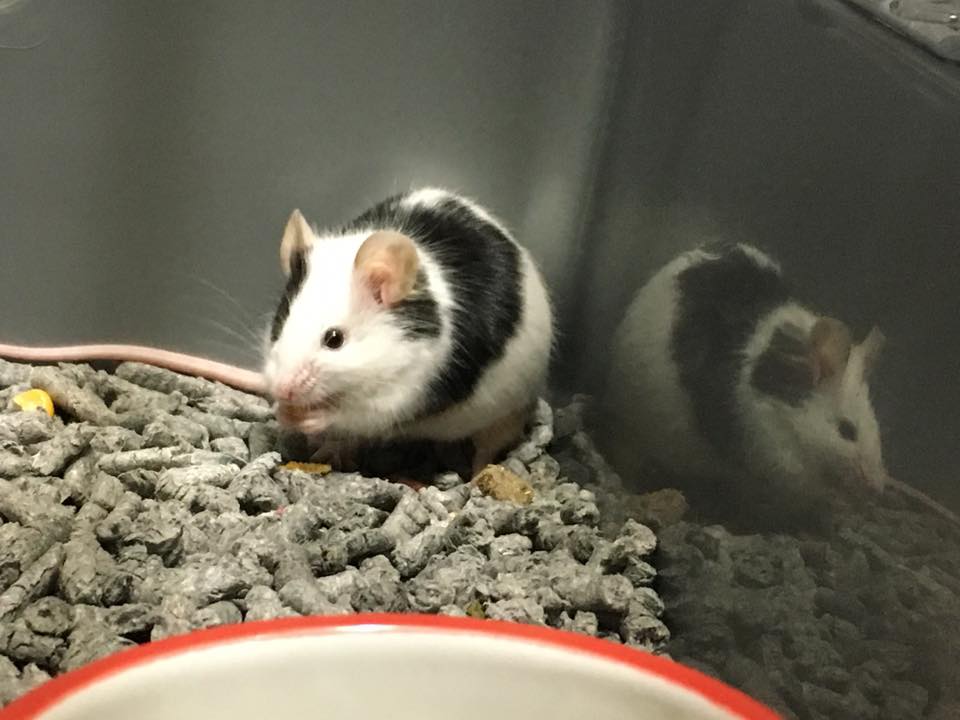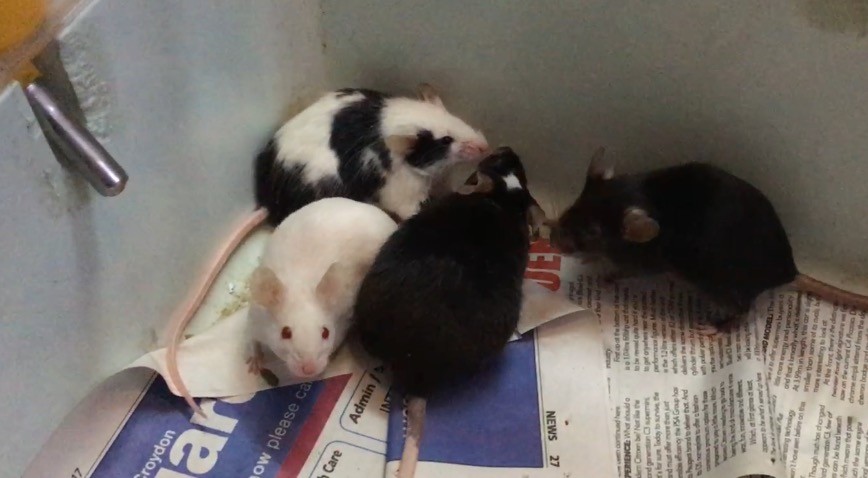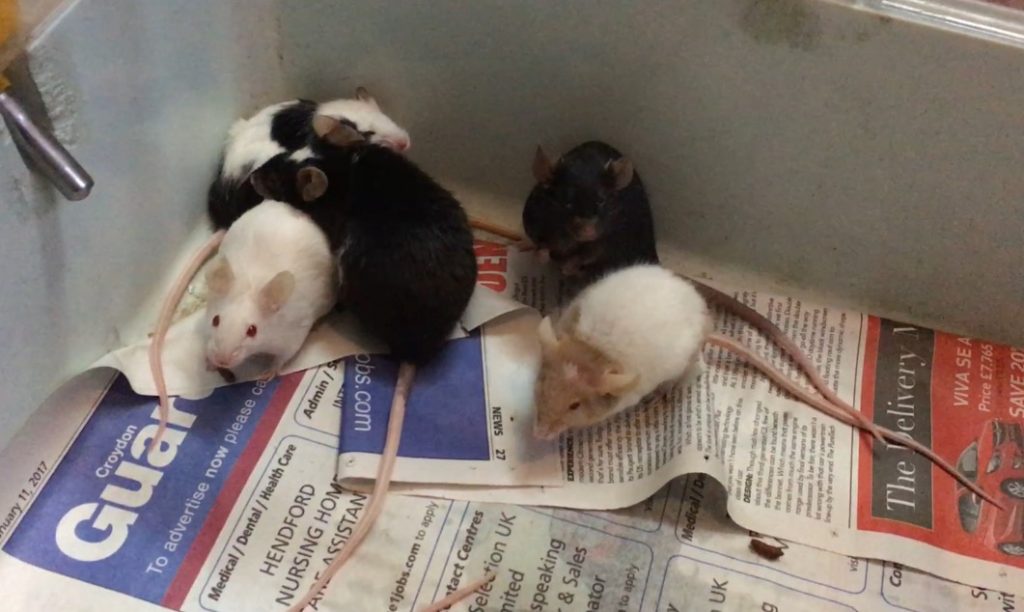Fancy mice make great pets and are sociable little animals. There may be times where you need to introduce new mice to your group, perhaps you have an older mouse and want her to have friends, or you just wanted more. Whatever the reason, mice should be introduced carefully to increase the success rate of bonding. Generally, it is easiest to introduce female mice to other females, and first-time mice keepers are encouraged to keep girls.
There are many different methods to bonding, but this one works best for me and having kept mice for a number of years, I always rescue more when my group gets smaller so I am never left with a lone mouse. I always chose a time when I am not in a rush and can dedicate a few hours to keep an eye on things. It goes without saying that these things cannot be rushed and some bonds are easy, whilst others take a bit more time.

The first step is to ensure the cage is completely clean, so I wash it out with warm water and disinfect the base and the bars. I remove all toys, beds, houses and bowls, wash and disinfect them, and leave them out until the group is fully bonded. This is because my mice seem to favour some toys over others and I don’t want anything to smell of them or they could defend it. As I don’t want to leave my mice in an empty cage, I collect together lots of cardboard boxes so they have things to hide and play in, but it is all nice and neutral. I never give them any boxes where they could feel trapped and cut small ‘escape holes’ in the back of them so no mouse is ever cornered. If you are introducing babies to adults, it might be an idea to put small boxes in that only the babies can fit in so they can hide away if they feel it’s needed.
Once the cage is ready, I put both groups of mice in a spare cage with newspaper in and let them meet. If I have an established group and a couple of new babies, I will put the babies in the bonding cage first, and then add one adult at a time as to not overwhelm them. Some keepers swear by adding a drop of vanilla essence to the back of each mouse so they all smell the same and it will confuse the scents. They usually sniff each other, and sometimes there will be a bit of squeaking. I leave them together for a while in the bonding cage, but the length of time will depend on how they are reacting to each other. As long as there isn’t any fighting or blood, I then move on to the next step, which is to place the new mice in the clean cage. This gives them a bit of time to get their bearings and investigate, before adding one mouse from the established group at a time. Again, there is usually chattering, squeaking or chasing as they work out who is top mouse, but as long as there is no blood, I let them work it out on their own.

If you have a mouse who is picking on the new ones, it is best to give them a time out for 10 minutes to half an hour to let them calm down. It’s really important that you remove the bully and not the ones being bullied, otherwise, the bully will think they have won! You may need to do this a couple of times, but they should settle down. I have only had one female mouse that I have struggled to bond other mice with. No matter how carefully I tried to introduce new mice, she would whip and vibrate her tail and then launch into an attack. Luckily I have a neutered male mouse living with her, and they both seem pretty happy with this bond so I have kept them in a pair, separate from the main group so everyone is now living in harmony.
I find mice are happiest in small groups and although it can be quite daunting to introduce mice, it’s definitely worth it when you see them interacting with each other. Scuffles can last for a couple of days after they move in together, but it usually calms down after this and it’s best to leave them to it unless a mouse is being bullied or blood is being drawn. I will scatter feed them until at least a week after they have gone in together so there isn’t any competition over food. I also won’t give them any treats as I don’t want them to squabble over high-value food at this stage. After this first week, I will give them their cleaned toys back and everything will be back to normal until I fall in love with another mouse who needs help!
If you are still deciding on adopting mice, or already own them but are looking for some tips, have a look at this post on 10 things you need to know before owning mice.
Have you bonded mice? Let me know in the comments what your experience has been like.


I found this interesting and informative. Thanks so much. I have never had mice before simply because I don’t know enough about them. Could you please write a blog on bonding rats and maybe even socialising rats who have not been handled!!!
I’ve grown up with small/med/lg animals my whole life and my fiancé and I wanted to get our son a hamster and he ended up wanting a mouse. So our little sweet pea came along and kids do grow bored of small animals so her and I bonded very well and she is very therapeutic to me when I need it.
Thank you for this post. We had a pair of female mice and sadly one died. We got a new female friend for the remaining one and used this post to successfully bond them. Thank you!
I bought two females a few months ago and one had babies (three boys and a girl), I later donated the boys to a pet store and bought what I was told were two females later on two separate occasions (I should have checked for myself that both were female). The new female Polly Anne is very timid but also very friendly to people and the other is Dutch, who I double checked two days later to find is a male. I was hoping to slowly integrate Polly to the other females, but Tofu and Marble are the largest and most territorial (after trying to introduce Polly, Marble pounced on her and I took her out immediately. Marble’s daughter Jasmine tried to box with her mother to challenge for alpha status after that also). Tofu had been separated out already from trying to eat Marble’s litter and hasn’t been reintroduced yet (I’m hoping until Jasmine is older to meet with her slowly). So I’m worried about having no spot to place Dutch away from the others and the fact that he already spent two-three nights in Polly’s cage before, while I was socializing them further, I had to double check Dutch and saw he is male. I’m worried she’s too small, and I didn’t want any of the mice to get pregnant again since that was the whole point of donating the boys from Marble’s litter – temporarily named Billy, Jo, and Billy Jo). If I return Dutch now I’m worried Polly is already pregnant and would be lonely once he’s gone. Any good advice? Aside from always being sure to check the mice before getting them. That was on me.
Male mice can be neutered, so if you wanted to keep Dutch, you could look into that. In regards to bonding them, some mice can be tricky to bond! I advice always using a neutral area and building up the time they spend together. You can then progress to short periods sharing the cage. Always offer lots of resources eg food, hides etc to reduce competition.
I thank you for sharing your experience, there’s not a lot of information out there about keeping pet mice. I have a new mouse that I must introduce to an established troop and will follow your method. Hopefully I can have her with the older mice and she won’t be able to bully any of them as she did with the other troop I am trying to establish. I recently rescued a little runt-looking sort of mouse (female) and she was constantly getting thumped on. Maybe you might offer me some advise on how to keep the smallest member from getting picked on or boxed out. I would appreciate any insights you might have.
Hi
Could you provide the smallest mouse with a box or hide that’s only small enough for her to get in to? There will be some sort of hierarchy and I have kept runts in large groups so it can be done. I also scatter feed to ensure all mice get a fair share and one bully doesn’t guard the food bowl. Make sure there are lots of resources e.g. hides, toys, food so they will be less likely to squabble over things.
Hi Anna
We brought home a single female mouse from the pet shop as there was only one available, and we returned a week later for another female to keep her company. The original mouse we named Caramel and she was about 8-10 weeks old. Not sure how long she had been alone. We called the new one Syrup and she was only 3 weeks old. We introduced them last Sunday and there was a bit of chasing and biting at first but things have settled down a lot since then and they mostly get on very well together. However, Caramel does occasionally chase Syrup around the cage, and I noticed today that Syrup has been bitten at the top of the tail (there is blood). I feel like we are making progress and want to persevere if we can, but is this occasional bullying normal for 1 week in, and do you think we should ride it out or separate them immediately? I will disinfect the cage tomorrow and put in neutral toys to see if that helps.
Thanks for the info! One question I had though — how can you tell if a mouse is being bullied vs. simply trying to establish dominance?
I’m introducing Tundra (my adult mouse who I’ve had for a while) to Savanna and Chaparral (new, young mice). I created a neutral minimalist space to introduce them. Sav is a submissive little sweetie and has thus far not had any scuffles with Tundra at all — Chap, on the other hand, has had about 3-4 squeaky scuffles with Tundra (no blood) — but they also seem able and willing to occupy the same hide space for a while with minimal issues. Tundra seems to be “starting it” more often. If she’s fine with Sav, can I assume she and Chap are simply trying to work out who’s top mouse and that their scuffles are safe?
Hi. Generally if blood is being drawn, that is when I would stop trying. It sounds as though your mice are, as you said, trying to establish a hierarchy within their group. Try scatter feeding until they have worked it out and add a few extra bed so Chap can have access to food and somewhere to sleep incase Tundra is preventing him from doing so.
Love your video and knowledge. I have had mice for about 40 years now and never had to intro a single one to a group yet. So an oldie, close to two years or even older, with the sniffles who just ended up alone when her last companion died of old age yesterday. I have another healthy group in a seperate tank in another room. They are about 7 months old. I hate for my old mousie to be alone but also don’t want the healthy group get the sniffles from her. What to do?
Hope you read this and am looking for your feedback.